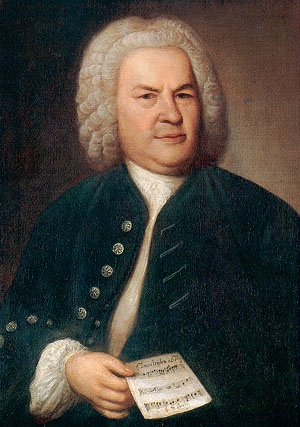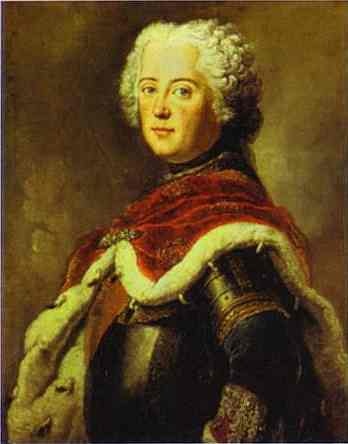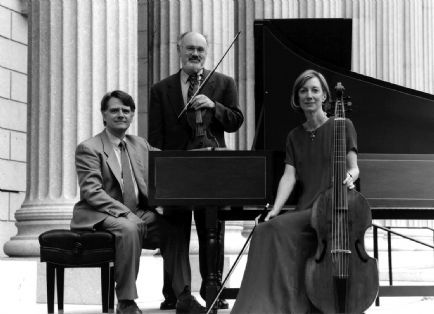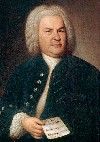Aston Magna: Johann Sebastian Bach and King Frederick the Great Meet Again
this time, more cordially
By: Michael Miller - Jul 17, 2007
Aston Magna Summer Festival: Bach at the court of Frederick the GreatJuly 14, 5:00 P.M.: The Daniel Arts Center
King Frederick the Great, Concerto No. 3 in C Major for Transverse Flute and Strings
C.P.E. Bach, Trio Sonata, "Sangineus et Melancholicus," W. 161, No. 1 for tranverse Flute, Strings, and Continuo
J. S. Bach, A Musical Offering
John Gibbons, fortepiano
Christopher Krueger, baroque flute
Daniel Stepner, baroque violin
Jane Starkman, baroque violin and viola
Laura Jeppesen, viola da gamba
In their characteristically gracious and unpretentious way the musicians of Aston Magna recreated the cultural context of a very great piece of music, J. S. Bach's Musical Offering, or at least the very best aspects of that context. By introducing the piece with King Frederick the Great's concerto and C. P. E. Bach's unusual trio sonata, they gave the audience the essence, at least in a purified form, of the human milieu in which the Musical Offering was created. Frederick's fluent and engaging concerto represents the very type of music as conversation, or rather an extension of human conversation, a high form of art in itself, into the mathematical realm of music, embodying the intimate connection between music and speech, a reality which was vividly present for educated people of the time, J. S. Bach himself above all. As we listen to Frederick's concerto, we can hear the spoken conversation in the room as the King and his court prepared for the evening's music, a continuation of the conversation on what was accepted as a higher level, since it was expressed in a language of divine numbers and proportions—all natural enough in a culture in which professional musicians wrote for musically trained patrons who participated in the performances themselves, not a passive audience who sit in rows and listen to musicians playing on a proscenium stage. (We have already seen that this summer in Lully's Psyché.)
The trio sonata by C. P. E. Bach, who was a somewhat underappreciated employee of King Frederick, makes this even clearer, since the music imitates a dialogue between two individuals of different temperament, the melancholic and the sanguine. Of course it can only be presented as an argument between the two, each making the case for his own humor. Here the broken phrases imitate the interruptions of conversational speech, eventually leading into a sort of synthesis, in which the two join to make fully developed music.
Prepared in this way, we are ready to listen to the Musical Offering as part of an exchange between old Bach and the Prussian king, who had summoned him to court and asked him to improvise a fugue on a theme he played for him on one of his new-fangled fortepianos. The story is well-known, even more so following the 2005 publication of James R. Gaines' Evening in the Palace of Reason, a fine example of pop history, in which the author explores the many important corollaries of this historic meeting—an especially significant one, because it was really a confrontation between two generations, the sixty-two-year-old Bach's already outmoded world of faith and arcane higher wisdom and thirty-five-year-old Frederick's ascendant world of reason and French fashion, which rejected everything the elderly composer stood for. (Once again, I can refer you to an interview with the author by Tom Ashbrook on On Point.) This encounter was not of the most pleasant sort, in fact, as Daniel Stepner reminded the audience when introducing the Musical Offering.
Taking as his point of departure a 1950 essay by Arnold Schönberg, Gaines dilates on the malicious intent behind the king's invitation. Conditioned by his own sufferings at the hands of his deranged father, Frederick was endowed with a truly impressive mean streak. As his sometime friend Voltaire said that if Frederick called you his friend, he meant his slave; "my very dear friend" "you mean less than nothing to me;" "come to dinner" meant "I feel like making fun of you tonight." What's more, music was one of Frederick's deepest loves, one he had paid for quite dearly, and he was unquestionably an accomplished composer and flautist, one who had very definite opinions in favor of the new galant style, which had already marginalized Bach père. Frederick had told Philipp Emmanuel several times that he was curious to meet the old man, whom he clearly regarded as a superannuated provincial, and it was eventually arranged. As soon as Bach arrived in an all-night coach, Frederick summoned him to court and presented him with his challenge, a theme, which was so long and so full of chromatic intervals that it was next to impossible to work into counterpoint. Schoenberg speculates that Philipp Emmanuel may have been its composer, either under compulsion from Fredrick or from some odd Freudian motive of his own. The exhausted old man succeeded in improvising a three-part fugue on the spot, playing one of Frederick's collection of fortepianos, but when Frederick challenged him to top it with a six-part fugue, he demurred, composing this exercise in a form he had never before attempted at home. Frederick's Schadenfreude is undeniable, even though Schoenberg himself looked at it in more professional terms. Some weeks later Bach sent Frederick, not only the two fugues, to which he gave the archaic name ricercare, but also ten canonical puzzles, and a trio sonata with a difficult flute part, which was probably beyond Frederick's abilities.
The circumstances of the Offering's creation make it clear that, far from being purely abstract and intellectual compositions, they are eminently and naturally playable by a chamber group, and fit easily into the milieu of courtly musical conversation, if in a more formal language than that of Frederick and Philipp Emmanuel. In fact twentieth century scholarship found a fruitful vein in the role of classical rhetoric in Bach's conception of the form and structure of the music. It is important to remember that Bach was learned in Latin, loved the classical authors, and taught the subject in the course of his duties at various times. For Bach the connection between music and language was truly a deep one.
The story also explains why we hear a distinguished specialist in early music, John Gibbons, playing the ricercari on a piano with a good deal of rubato and a fair bit of pedal. If he had been playing a modern piano we would have thought of the great Bach interpreters of the past like Edwin Fischer, Walter Gieseking, or Rosalyn Tureck, but in fact Mr. Gibbons was recreating the sound of that first improvisation at Potsdam. There was nothing "abstract" about these performances. They were full of life and expression, as were the contributions of the other musicians. Daniel Stepner exercised his leading role with his usual kindliness and discretion, playing with temperament and a wide range of color and inflection. Christopher Krueger played his baroque flute with virtuosity, focus, and a handsome, rich tone. Jane Starkman, who alternated on baroque violin and viola, gave strong support, and Laura Jeppesen, playing viola da gamba, was thrilling to hear, with her lovely color in all registers, and sensitive expression.
As for the much-debated order of the individual pieces, Aston Magna followed almost the same pattern they adopted in their recording of ten years ago. They began with the three-part ricercare, placing the six-part in a central position, framed by the first six canons before it and after it two more canons, as well as the four-movement trio sonata. As most of the audience began to applaud the elegant performance of the sonata, Mr. Stepner raised his hand and smiled mischievously. As an encore he proposed the tenth canon, a natural enough follow-up to the trio sonata and the entire sequence. Most of us, including myself, should have counted more carefully, or at least sensed that something was missing. This gentle test once again brought us back into the spirit of that first encounter between the king and the composer.
Web: http://homepages.nyu.edu/~mjm11/index.html
e-mail: heliagoras@gmail.com




